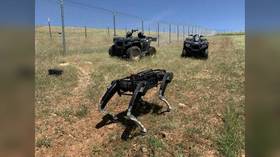Border patrol testing robot dogs

The US Department of Homeland Security has offered a pack of robot dogs – officially named ‘Automated Ground Surveillance Vehicles’ – to Customs and Border Patrol for use in monitoring the vast border with Mexico.
The program intends to “leverage technology to force-multiply” the agency’s presence along the border and “reduce human exposure to life-threatening hazards,” according to a press release posted on Tuesday, which praised the four-legged bots’ performance on harsh terrain.
“The southern border can be an inhospitable place for man and beast, and that is exactly why a machine may excel there,” DHS Science and Technology program manager Brenda Long explained in the statement.
In 2020, the US military also worked with the dogs’ manufacturer, Ghost Robotics, to patrol military bases, while the company itself has collaborated with gun manufacturer SWORD International to create an armed version of its dogs, capable of taking down targets almost 4,000 feet away.
The unarmed models have already been tested on “sentry duty,” in which they are unleashed autonomously to patrol a pre-set perimeter while armed with cameras and other sensor devices. The test runs have included inspecting railroad cars and carriages as well as searching residential buildings, and include “a scenario that simulated being met by potentially hostile individuals.”
The four-legged robotic sentries can be equipped with any kind of camera (thermal, night-vision etc.) or sensors, including chemical, biological, radiological, and nuclear. They can be controlled via radio, wi-fi, GPS, or “other means,” according to the press release, leaving open the troubling possibility of remote hijacking by hackers.
The DHS press release seemed designed to defuse any fear associated with the robot dogs, repeatedly referring to the 100-pound machines as man’s or officer’s “best friend” and using veterinary terms to describe their anatomy (“paws” instead of treads, etc).
However, the device’s manufacturers felt no need to conceal their enthusiasm at its capabilities, boasting that the “rugged, quadruped robot” can traverse “all types of natural terrain including sand, rocks and hills, as well as human-built environments, like stairs.”













